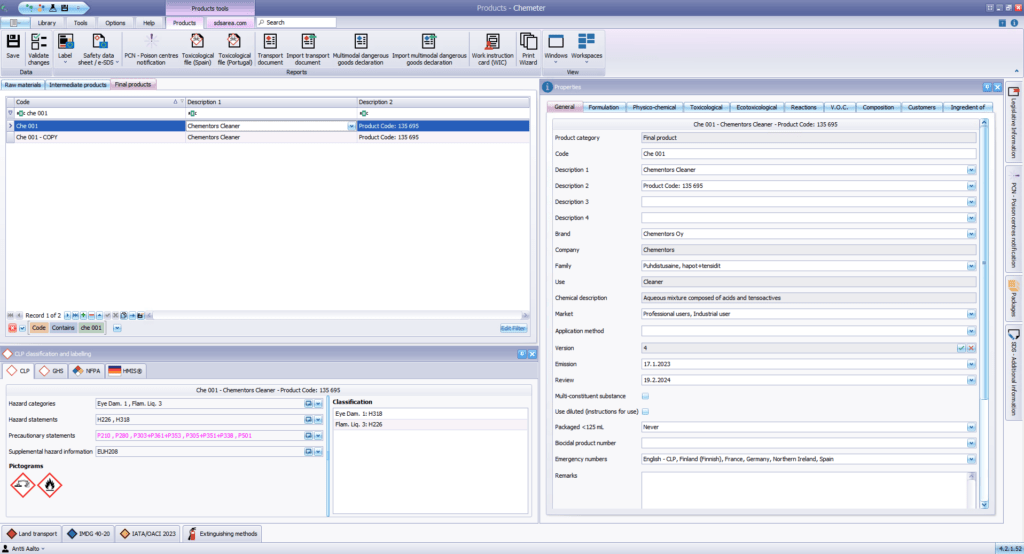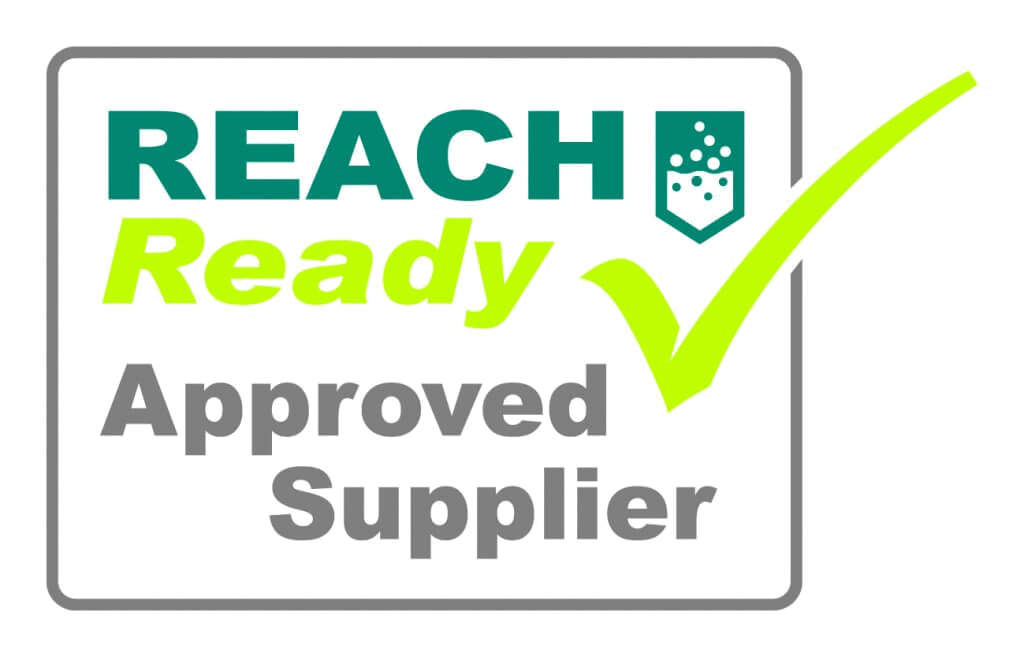Cosmetics and DGSA Specialist
Phone +358 10 504 5860
satu.salomaki@chementors.eu
Finnish | English
We author fully compliant SDS documents according to the legislation and languages of over 60 countries.
We write SDSs for the following industries:
More than 10,000 safety data sheets created
For 60 countries
For over 350 customers
All our safety data sheets are written in compliance with local regulations (GHS and CLP) and international harmonized regulations on the transport of dangerous goods.
By distributing compliant SDSs, companies can maintain confidence in terms of legal manufacturing, importing, and trading activities while contributing significantly to global efforts in protecting human health and the environment.
Due to the importance of SDSs (formerly material data sheet or MSDS) to the protection of human health and the environment, it is critical and, in some countries, legally required that the document is prepared by a person who has relevant and sufficient competency to write a compliant SDS (formerly MSDS).
Understanding this basic condition, we have formed a team of experts who have extensive know-how in chemistry and chemical laws and are highly experienced in safety data sheet authoring. We also have regular refresher training to keep up with revisions in global chemical regulations.
Thanks to years of working on the SDS compilation tasks, we are familiar with local requirements and common issues which enables us to establish an all-in service. We know what to follow. Once necessary information is provided, our experts will take care of the whole process.
We have up-to-date SDS authoring software – Chemeter – which integrates requirements and criteria set in local regulations of 60 countries around the world.
This allows us to create compliant SDSs in the required language(s) of the target market in a short lead time.
At each step, our experts keep assessing the details and monitor the wholeness of the content to ensure the quality of the safety data sheet (formerly material data sheet or MSDS). Writing a safety data sheet in a clear, comprehensive, and precise manner with fast delivery time is our internal criteria.

During the process, we maintain responsive communication with customers to ensure that all project needs and legal requirements are satisfied.
We also pay attention to the visual aspect of the SDS by applying the customer’s logo and color theme to the document for a sleek and customized look.
In addition, upon request, we will evaluate the existing data and relevant regulations to consult possible options for reformulation to minimize the hazard classification of the product, or for substitution of hazardous ingredients to safer ones.
We also provide the service of compiling the extended safety data sheets with exposure scenarios for cases in which eSDS is required by the regulation.
At Chementors, we put our best efforts into generating qualified safety data sheets that are legally compliant, scientifically meaningful, and visually sleek.
Your safety data sheet (SDS or MSDS) will be created by assessing the product formulation with the local regulations where the product is manufactured, distributed, or sold.
To proceed with the task, we need the following information:
We recommend to make the following information available:
Then we take care of the rest.
- Comprehensive data gathering - Active communication with customers
- Checks on details to ensure accuracy - Assessment of the wholeness to ensure consistency - Final evaluation to ensure the compliance of the ready-to-go SDS
- Tailored SDS authoring solutions based on industry & product specifics and client requirements.

Phone +358 10 504 5860
satu.salomaki@chementors.eu
Finnish | English

Phone +84 39 6169 628
mi.nguyen@chementors.eu
English | Vietnamese

Phone | +358 9 2316 7090
antti.aalto@chementors.eu
Finnish | English
| Argentina | Ecuador | Luxembourg | Serbia |
| Australia | El Salvador | Malaysia | Singapore |
| Austria | Estonia | Malta | Slovakia |
| Bangladesh | Finland | Mexico | Slovenia |
| Belgium | France | Morocco | Spain |
| Brazil | Germany | New Zealand | South Africa |
| Bulgaria | Greece | Nicaragua | South Korea |
| Canada | Guatemala | Norway | Sweden |
| Chile | Honduras | Pakistan | Switzerland |
| China | Hungary | Panama | Thailand |
| Colombia | India | Paraguay | The Netherlands |
| Cyprus | Indonesia | Peru | The Ukraine |
| Costa Rica | Ireland | Poland | Turkey |
| Croatia | Italy | Portugal | United Kingdom |
| Czech Republic | Japan | Puerto Rico | Uruguay |
| Denmark | Latvia | Romania | USA |
| Dominican Republic | Lithuania | Russia | Vietnam |
We also offer an extended safety data sheet (eSDS) authoring service for products placed on the EU market that fall into the scope of the eSDS obligation.
An extended safety data sheet is a document that has an exposure scenario attached to the SDS as an annex, contains the conditions of safe use (operational conditions) and risk management measures for identified uses (at the whole life cycle stages) that are relevant to the recipient of the substance. An eSDS must be written clearly and comprehensively using standard phrases and the agreed format.
The purpose of the exposure scenario is to provide users in the supply chain with relevant information on how to use the substance in a way that potential risks to workers, consumers, and the environment are controlled.
Under the EU REACH regulation (EC) 1907/2006, eSDS is required when the substance is placed on the market in quantities of 10 tons per year or more and is classified under certain hazard classes or categories.
If a mixture for which an SDS is required contains substances that must have an eSDS according to the REACH regulation, the exposure scenarios for these substances must be attached to the extended safety data sheet of the mixture in question, if the amount of the substance exceeds the limits defined in the REACH regulation.
There are specific deadlines to have the eSDS ready, for example:
No later than the date on which the substance or mixture is first supplied.
When a downstream user requests an addition of a new use, the revised eSDS must be submitted before the next delivery of the substance as such or in a mixture (provided that the request is made at least 1 month before delivery), or within one month of making the request - whichever is later.
When receiving a safety data sheet having a REACH registration number from the supplier, downstream users shall have 12 months to implement the conditions of use included in the exposure scenarios for their uses or to take appropriate actions, for example, the eSDS for the mixture.
The duty holders who must comply with the above requirements are manufacturers, importers, and downstream users. The requirements and deadlines for each operator will be defined on a case-by-case basis, according to the regulation.
Please contact our experts to check if eSDS is required and to know your obligations in providing an eSDS for your relevant uses. We are also ready to handle the eSDS compilation task on your behalf.
+358 44 974 0601
Following the Globally Harmonized System of Classification and Labelling of Chemicals (GHS), a standard developed by the United Nations (UN) to globally standardize and harmonize the classification and labeling of chemicals, different countries and regions in the world have implemented country or region-specific SDS (formerly MSDS) regulations based on the UN-GHS version.
Under most national or regional GHS, it is a legal obligation to provide the safety data sheet of the product to downstream users in the supply chain.
The safety data sheet (SDS) must fulfill all requirements and criteria set in the local regulations where the product is manufactured or placed including the required content, standard phrases, and format.
In most countries and region-specific GHS regulations, safety data sheets must be written in the country’s official language(s) where the product is manufactured and/or distributed.
In Europe, the requirements on the format and content of safety data sheets are regulated by the REACH Regulation (EC) No. 1907/2006, while the criteria for classification and labeling of substances and mixtures are determined by the CLP Regulation (EC) No. 1272/2008.
In addition, according to the EU REACH Regulation, an extended safety data sheet (eSDS) is required if a substance is put on the market in the quantity of 10 tons per year or more and the substance is classified under certain hazard classes or categories.
In such cases, exposure scenarios should be attached to the SDS as an annex.
Under different national and regional SDS regulations, it is required to provide a compliant safety data sheet to downstream users in the supply chain.
A safety data sheet (formerly material safety data sheet or MSDS) is a document that contains comprehensive information on the properties and hazards of the substance or mixture, protective measures, and safety precautions.
The purpose of an SDS is to provide comprehensive instructions on the safe use of a substance or a mixture which will consequently improve the protection of human and environmental health.
Basically, SDSs are intended for professional users and handlers of the products and should always be received from the supplier of the product. The safety data sheet is not primarily intended for consumers, but it should also be provided to the consumers when there is a request.
Frequently asked questions
Jani Määttä and Jan Nylund founded Chementors in 2012 because of the increasing need for regulatory consulting in the chemical industry, based on their own previous experience in the field.
The Chementors team consists of experts who are top professionals in their field. We cooperate closely with the authorities, so we are up to date on changes in laws and regulations. Chementors also has an extensive network of companies in various market areas.
We will tailor the price for you case-by-case, for example, according to the order quantity. You can order work for one or more SDSs at a time.
Yes, you can outsource various chemical safety issues to Chementors. Contact us to learn more about outsourcing!
The company must have safety data sheets for substances and mixtures that it manufactures or imports to the EU. Preparing SDSs requires specific expertise, so the company can use a professional consultant, such as Chementors, to prepare them.
All companies that supply chemicals are responsible for the correct content of safety data sheets and their distribution, even if they did not prepare them themselves. Chementors offers various solutions for authoring, translating, and distributing safety data sheets according to up-to-date regulations.
SDSs must also be provided on request for the following chemicals:
The company supplying the chemical must submit a safety data sheet to its customer as soon as the chemical is delivered to them for the first time, and when the SDS has been updated for various reasons. The safety data sheet must always be provided to professional users, but to consumer customers only upon request.
The safety data sheet can be delivered, for example, as a pdf file via e-mail or in paper form. Providing safety data sheets through a website is not enough; it must be delivered provenly to the customer, for example, as a permanent link that leads directly to the SDS file.
Countries require SDSs to be provided in official languages. In Finland, for example, the safety data sheet must be provided in either Finnish, Swedish, or both languages according to the customer’s wishes.
According to the REACH regulation, an extended safety data sheet (eSDS) is required if the substance is placed on the market in quantities of 10 tons/year or more and is classified as dangerous. If the extended safety data sheets (eSDS) of the substances in the mixture are available, the relevant parts of the exposure scenario must also be attached to the safety data sheets of the mixtures.
Once the necessary information is made available to us, we are able to deliver the SDS within a couple of days. Chementors also has an express delivery service for urgent cases where the SDS shall be ready in the next working day.
Yes, we do. We provide translations of safety data sheets according to the legislation for over 60 languages. For more information about Chementors’ SDS translation service, please visit this link.




Chementors Ltd | Finland | Hong Kong | Vietnam | info@chementors.fi